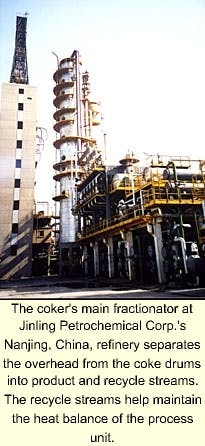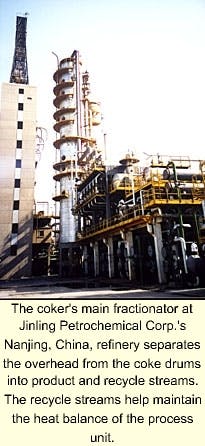A heat-balance design associated with the revamp of a delayed coker in the Nanjing, China, refinery saves about $101,000/year in energy consumption.
In 1999, Jinling Petrochemical Corp. developed a new heat-balance pumparound design for the main column of the delayed coker in its Nanjing refinery. This was part of the project that expanded the capacity of the delayed coking unit from 1.0 million tonnes/year (tpy) to 1.2 million tpy.
The revamped delayed coker received a new absorber-stabilizer system. The absorber absorbs C3+ components into a C1-C5 stream, and the deabsorber boils away C1 and C2 streams.
The coker used the light coker gas oil (LCGO) as the heat for the stabilizer-column reboiler and the diesel as the heat for the deabsorber-column reboiler. Previously, the LCGO provided the heat for both the stabilizer and deabsorber reboilers.
New, old heat balances
Delayed cokers usually have three heat sources of high temperature: heavy coker gas oil (HCGO), LCGO, and diesel oil. The temperatures of these streams are, respectively, 370° C., 320° C., and 223° C. Because of the small quantity of HCGO, the emphasis of heat recovery is on LCGO and diesel oil.
Fig. 1a shows the heat-balancing process before the revamp.
Before the revamp, a diesel oil air-cooler removed half of the diesel pumparound duty. As a result, the process did not recover all of the heat of the diesel oil. Using AspenPlus, a simulation software by Aspen Technology Inc., Cambridge, Mass., the refinery simulated a new design for the heat-balance across the pumparound.
Fig. 1b shows the new design. The LCGO stream has a new heat exchanger running coker furnace feed (vacuum resid) on the shell side to increase the temperature of the vacuum resid.
For the diesel stream, the refinery moved the diesel oil pump upstream of the vacuum resid and diesel oil heat exchanger. It uses the diesel oil as the hotter stream in the deabsorber reboiler. This is the reboiler that was previously in line with the LCGO-pumparound stream.
Table 1 shows that the adoption of the new pumparound designs increased the pumparound temperature by 60° C. (and thus increased the pumparound rate), raised the diesel pump power usage by 18.6%, and decreased the diesel air-cooler duty by 32%.
On the other hand, the new flow increases the amount of 1.0 MPa steam by 20%, to a rate of 9,560 kg/hr.
This new design saved RMB¥840,000/year, or $101,000/year, in unit energy consumption by decreasing the consumption by 7,400 kcal/tonne (feed). Table 2 compares the test-run data with those of the design in the new configuration.
The author
Zhang Yuhong is an engineer at the Jinling Petrochemical Design Institute in China. He is responsible for process and piping design. He has worked on major projects related to hydrodesulfurization, coking, and sulfur recovery. He has 6 years of experience working with AspenPlus and 2 years of experience with Caesar II. Zhang holds a BS in petroleum refining engineering from the Jiangsu Institute of Petrochemical Technology, Jiangsu Province, China.






